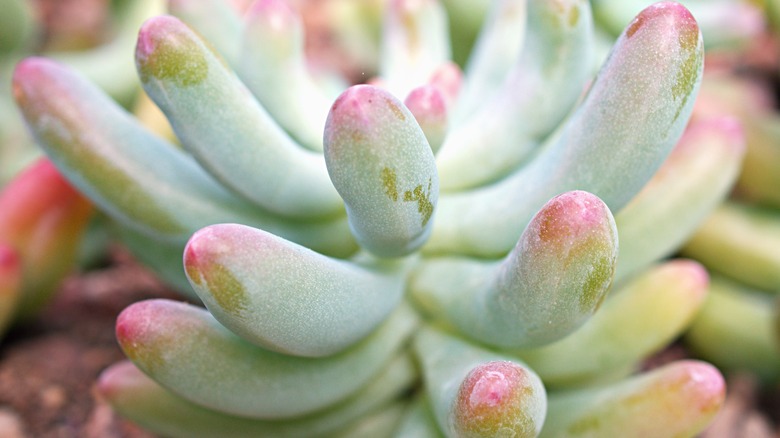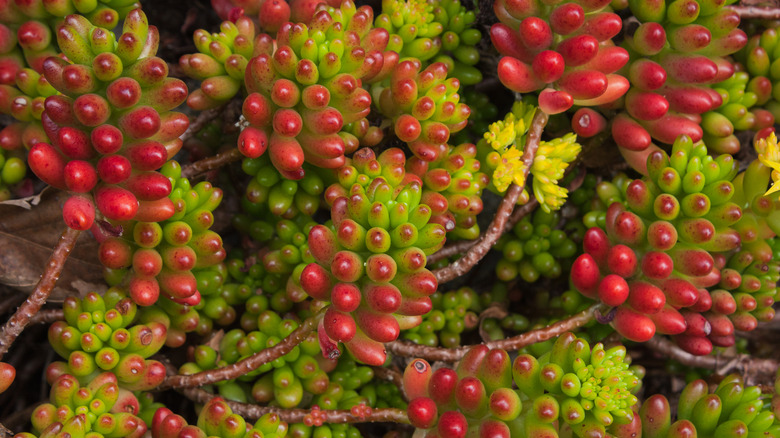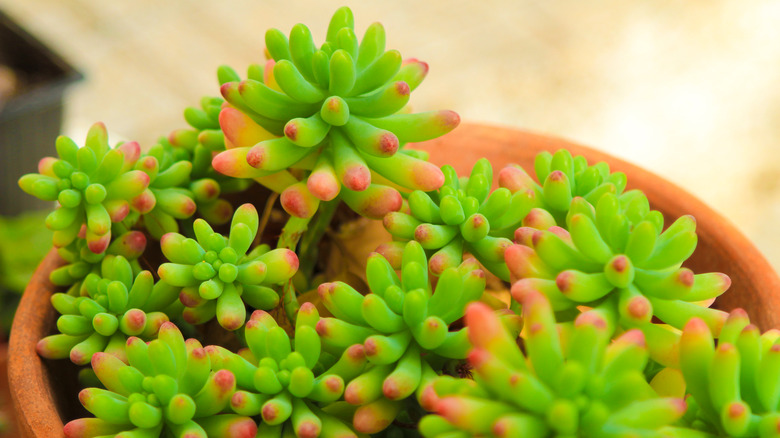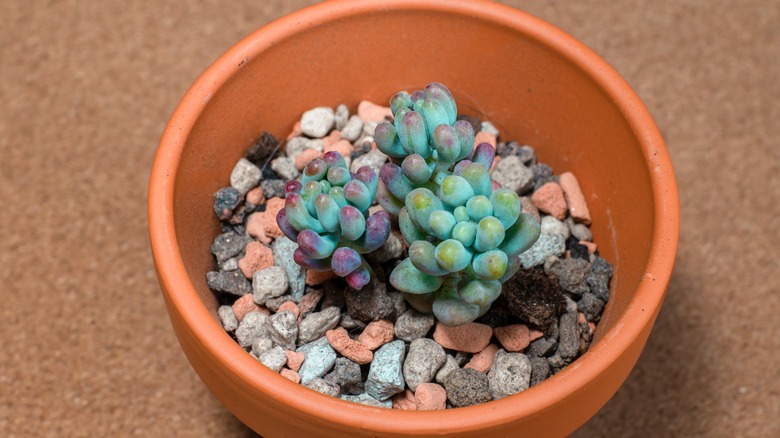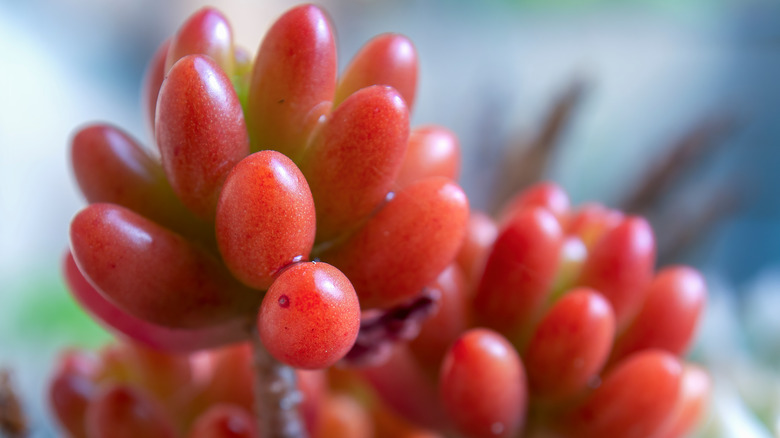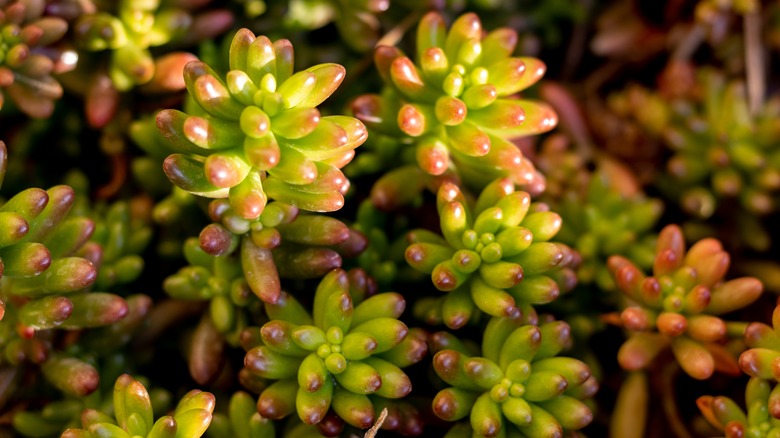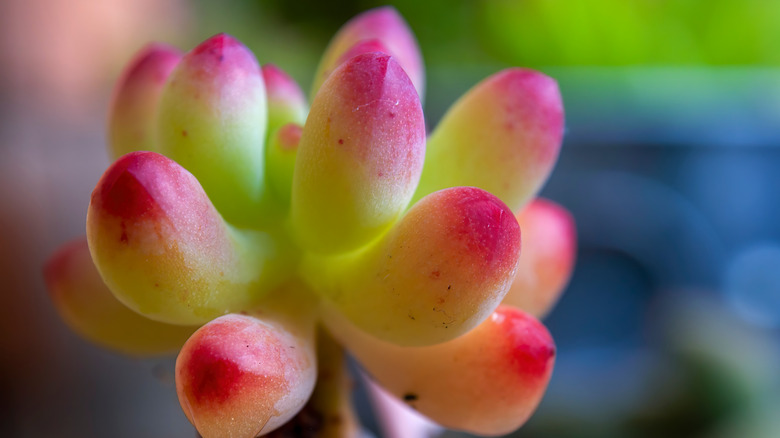How To Care For A Jelly Bean Plant
Jelly bean plants (Sedum Rubrotinctum) go by various nicknames, including pork and beans, Christmas cheer, and banana cactus. They are hybrid plants belonging to the Crassulaceae family and resulting from the cross-pollination of Sedum Stahili and Sedum Pachyphyllum varieties, per Gardening Know How. Like mistletoe cactus, they're often grown in hanging baskets that trail over the edges as the plant grows. But, unlike the mistletoe, they are toxic. There are two main types of this succulent native to Mexico: One is the green jelly bean, known for its bright green foliage, and the other is the aurora jelly bean, easily recognized by its more pink coloration, although it too may be variegated.
The plant's leaves, which resemble jelly beans, grow close to 0.7 inches and can reach nearly 8 inches tall. They also tend to favor growing to one side, and in their early stages of maturation, jelly bean plants often bloom yellow star-shaped flowers that will appear in abundance as winter turns to spring.
How to use jelly bean plants in the garden
Jelly bean plants are popular with gardeners, especially beginners, for two reasons: They do very well with next-to-no attention, and they're colorful. What's more, they're equally at home indoors and out, according to Succulents Box. When they're stressed (in a good way) by sunlight, a jelly bean plant's leaves will blush a radiant shade of red but go green when kept in shadier environments.
It is also possible to give them more heat than they can withstand, so make sure to provide them with some respite if your location gets the occasional summer heatwave. (That, of course, can be problematic if you've planted them in your garden and don't have a way to provide the necessary shade required.) Things get much more simple indoors. Your plant will be just fine if it gets no more than five or six hours of light a day. And they like facing any direction but north.
How to grow a jelly bean plant
Ask the experts at The Spruce, and they'll tell you that jelly bean plants can be easy to grow by either leaf propagation or cuttings. In fact, even leaves that have fallen can take root and, over time, develop into new plants. Begin by gingerly removing one leaf at a time by twisting them until the stem turns loose with a pop. It's best to do this without breaking either the stem or the leaf because new growth only occurs from a fully intact leaf base.
Now that you have the leaves to work with, you can place them in a new container on top of soil that's well-drained and find a spot to propagate them that's brightly but indirectly lit. Conversely, you could also place the leaves at the mother plant's base, which will provide some sunlight protection and lead to a more dense plant. Avoid watering your jelly bean plant until you see new roots, and return to a light watering schedule as you would with a fully grown plant.
How to care for a jelly bean plant
If you live in a warm climate year-round, you can leave these plants in the ground, GardenBeast says. Then, if it gets even hotter and you haven't seen rain in a while, you can water them a bit more, but make sure the soil is completely dry before you intervene. Investigate only after nine days or so to ensure it's dry to the touch or by testing deeper with a skewer stick. If you're going to make a mistake with these plants, it's overwatering them. Jelly bean plants can be hale and hearty in the winter months, but they're intolerant of consistently cold weather. Spend some time as the summer wanes into fall by digging them up if they're in your garden and transplanting them to containers.
If you get any kind of frost where you live, you risk killing your plants if you don't bring them indoors. Once inside, you'll want to position them to get a minimum of six hours of indirect sunlight a day at a window facing west or south. The plant's new home will likely make its leaves change color. Since they don't grow quickly, they are fine with being repotted every two years, and because their roots are shallow, they'll need compatible containers. Deeper ones could hold moisture that could create root rot conditions; they respond best to shallow containers with holes for drainage.
Jelly bean plant varieties
There are two main varieties of jelly bean flora. Although individual plants can appear in so many shades and hues, you'd be tempted to think there are more. Instead, they simply have a dynamic response to both heat and sun, which manifests in their leaves' colors. The plant has been heavily hybridized, gifting gardeners various new cultivars, Gardening Brain notes. Here are some popular jelly bean plants.
- The green jelly bean (Sedum Rubrotinctum) is easily recognized by its bright green leaves, which change to red during the summer months (per Succulents and Sunshine).
- Aurora jelly bean (Sedum Rubrotinctum) is an evergreen perennial succulent but has lighter leaves with a pinkish blush, cream, and lime green, Succulent Plant Care notes. In the summer, the aurora jelly bean will bloom flowers in clusters of brilliant yellow.
- Giant burro's tail (Sedum burrito) is a Pachyphyllum and Sedum Morganium hybrid. Gardening Know How explains that its thick stems look like they've been plaited with leaves.
- Sedum Santa Barbra (Sedum Rubrotinctum) is a hybrid of the Sedum pachyphyllum and Sedum rubrotinctum species, with round and meaty leaves spiraling up the stem (per Mountain Crest Gardens). Its hue ranges from green to crimson, with the strongest colors showing up when growing in direct sunshine.
Is the jelly bean plant toxic?
Most sites will tell you that the jelly bean plant may look tasty, but it's not edible and should be considered toxic, although not lethal. Some sources do list the plant as safe or mildly toxic to dogs and cats, but most recommend not gambling and keeping your plants out of reach from kids and pets. Be aware, too, that it helps to be vigilant because these plants shed leaves with very little provocation, and if they wind up in the wrong hands or paws, there could be trouble.
You'll also want to make sure you use gloves of some kind when attending to your jelly bean plants, the gardeners at Sublime Succulents recommend. They can harm the skin and generate an irritating rash otherwise. So here's a general rule: Proceed with caution, and if you think about it, the best way to ensure a healthy coexistence for both your plant and the other inhabitants of your home is to keep them high and out of reach.
How to repot a jelly bean plant
Jelly bean plants like lots of company and require very little room, so if you're looking forward to repotting them, you need to wait for a while. Depending on the plant and just how congested the space is, it will need repotting every two years or so. Once you've decided that the time is ripe, you can expect to lose some leaves in the process. Leave them where they fall in the garden because there's every possibility they'll take root and grow entirely on their own.
The experts at Succulent Plant Care note that you should wait until the soil around the plant is dry to repot because the plant will be easier to extract that way. If the plant is potted and you can lose the pot by cutting it, it's sometimes the best way to minimize jelly bean damage. You'll want a small spade to help you in the process of relocating your plant. Gently probe around the jelly bean's perimeter using the spade (don't forget your gloves), and you'll get your plant with little to no loss. Once you've placed it in a new home, you can fill your planter with a mixture of perlite and cactus soil. Toss in whatever leaves may have broken free because, again, some of those will propagate all by themselves.
